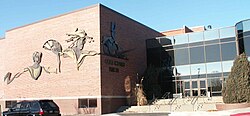
There are many cultural institutions and museums in Omaha, Nebraska. The city has a major museum, and several regionally important museums. [1] [2]
Contents
- Museums
- Art
- Art (encyclopedic collection)
- Botanic conservatory
- Children's
- Cultural
- History
- Specialized and historical
- Zoological
- Libraries
- Festivals and fairs
- Music, theater and performing arts
- Dance
- Opera
- Recording studios
- Symphony
- Theater
- Not-for-profit and university galleries
- References
- See also










